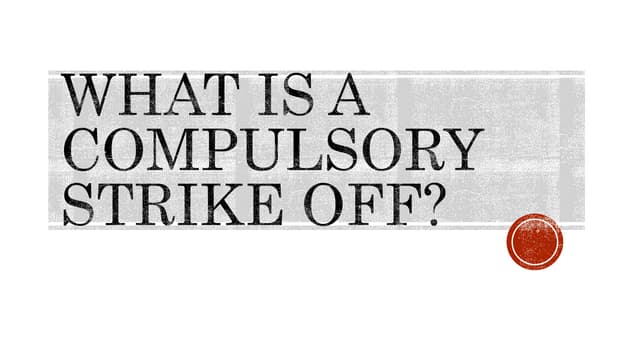Understanding Compulsory Strike Off: What You Need to Know
Wiki Article
A Comprehensive Guide to the Compulsory Strike Off Procedure in Corporate Administration
Browsing the detailed landscape of company governance needs an eager understanding of the treatments that govern the dissolution of entities. The mandatory strike off treatment, an important element in business administration, acts as a mechanism to enforce conformity and preserve the integrity of the business atmosphere. As organizations progress and scenarios modification, the need to strike off a firm might arise for numerous reasons. Checking out the complexities of this process, consisting of the lawful implications, procedural actions, and post-strike off factors to consider, uses invaluable insights for stakeholders looking for to navigate the intricacies of corporate governance.
Factors for Compulsory Strike Off
There are a number of vital factors that may motivate the initiation of a compulsory strike off procedure for a firm. Non-compliance with regulative needs can raise concerns about the business's procedures and financial health, leading to the choice to strike off the firm from the register.Furthermore, companies that have actually ceased trading or are no longer executing any kind of company tasks may additionally encounter compulsory strike off. This can be because of bankruptcy, mergings, or simply a choice to wind up the company. In such situations, maintaining the company on the register would serve no function and could potentially produce confusion amongst stakeholders.
Ultimately, the need of an obligatory strike off in corporate administration develops when a company is no much longer operating based on the law or has actually come to be obsolete, necessitating its elimination from the authorities records.
Lawful Implications and Risks
Offered the circumstances that trigger a compulsory strike off in corporate governance, it is critical to comprehend the lawful effects and threats related to such actions. When a business is struck off the main register, it discontinues to exist as a lawful entity. This can have major consequences for creditors, investors, and supervisors. Directors may deal with personal responsibility for company financial obligations incurred after the dissolution, subjecting their properties to potential seizure. Shareholders shed their financial investment in the company, and creditors may locate it testing to recover financial obligations owed to them.Additionally, there are legal consequences for individuals entailed in the monitoring of a business that has been forcibly struck off. They may be invalidated from working as directors in the future, face fines, or perhaps imprisonment if misconduct or deceptive activities are discovered. Furthermore, the reputational damages from a mandatory strike off can have long-term effects on people and their capacity to take part in future organization endeavors. Comprehending these lawful ramifications and threats is important for all stakeholders involved in the business administration process to guarantee and browse potential pitfalls compliance with the law.
Actions in the Strike Off Refine
Launching the required strike off process in company governance entails a series of prescribed actions outlined by regulative authorities. The very first step typically calls for the business to submit a formal application or notice to the pertinent government company or registrar signaling its intent to be struck off the official register. Ultimately, the company is usually required to clear up any outstanding responsibilities, financial obligations, or tax obligations to guarantee conformity with governing requirements.Once the initial documentation is sent and financial commitments are met, the regulative body will certainly release a notification in a similar publication or the main gazette to notify stakeholders concerning the upcoming strike off - first gazette notice. This notice offers as a final opportunity for any interested celebrations to raise objections or present valid reasons why the company need to not be liquified
Complying with the publication of the notice, the regulative authority will certainly continue with the strike off process if no substantial objections or challenges arise. The company will certainly then be formally liquified, and its name will certainly be gotten rid of from the register, effectively marking the conclusion of the required strike off treatment in corporate governance.
Files Needed for Strike Off
In compliance with regulatory guidelines, certain paperwork must be given to facilitate the strike off process in business governance. Additionally, financial declarations, such as the business's newest balance sheet, must be included to guarantee that all monetary commitments have been worked out before launching the strike off procedure. It is essential to make sure that all the requisite documents is carefully prepared and submitted in conformity with the suggested standards to accelerate the strike off procedure efficiently.Post-Strike Off Factors To Consider and responsibilities
Following the completion of the necessary documents for strike off, focus shifts to the post-strike off obligations and considerations that are important in the company governance procedure. Once a firm has actually been struck off the register, it is critical to guarantee that all staying properties are dealt with suitably. This includes dispersing any kind of continuing to be funds amongst investors and clearing up any arrearages or responsibilities. In addition, company supervisors must make sure that all tax obligation responsibilities are fulfilled, last staff member payments are made, and that all essential filings are completed with appropriate governing bodies.
Final Thought
In verdict, the required strike off procedure in corporate governance acts as a needed device to get rid of inoperative companies from the register. Understanding the reasons, lawful effects, actions, and records needed for strike off is essential for compliance with governing needs. It is very important for companies to fulfill their post-strike off commitments and consider the ramifications of this process in order to maintain excellent standing and prevent potential threats.
There are a number of crucial factors that may motivate the initiation of an obligatory strike off treatment for a business (first gazette notice for compulsory strike-off). Non-compliance with governing demands can elevate issues regarding the company's operations and monetary wellness, leading to the first gazette notice for compulsory strike off choice to strike off the firm from the register

Report this wiki page